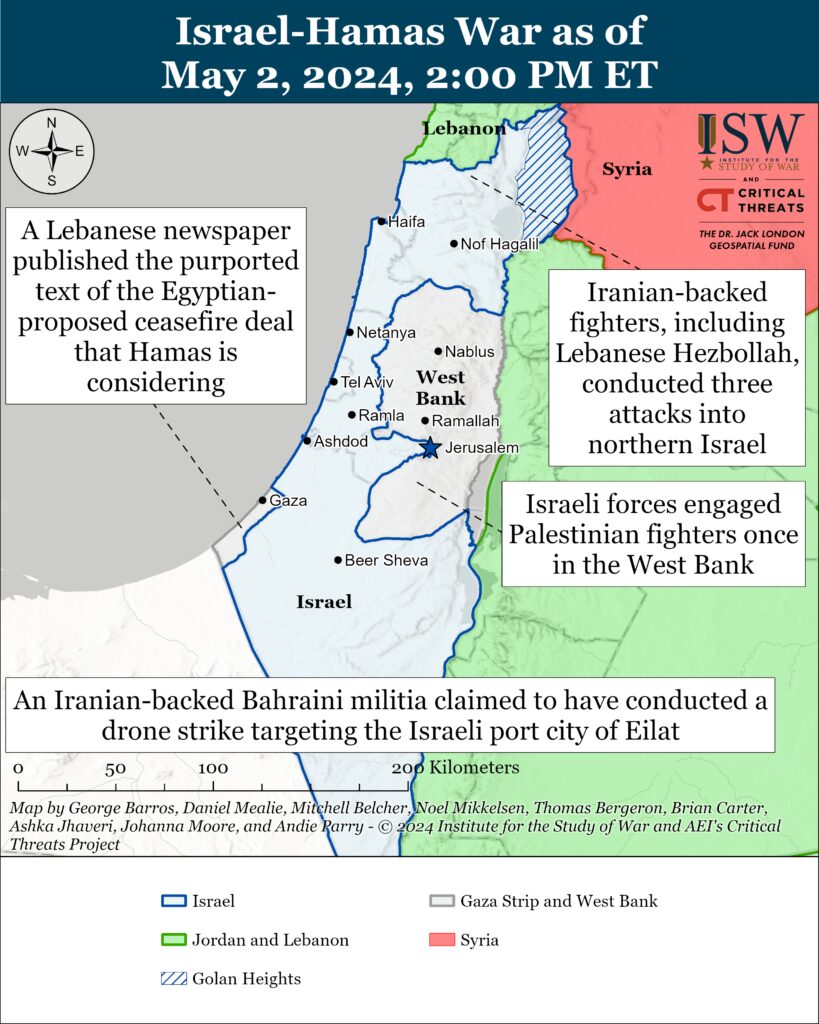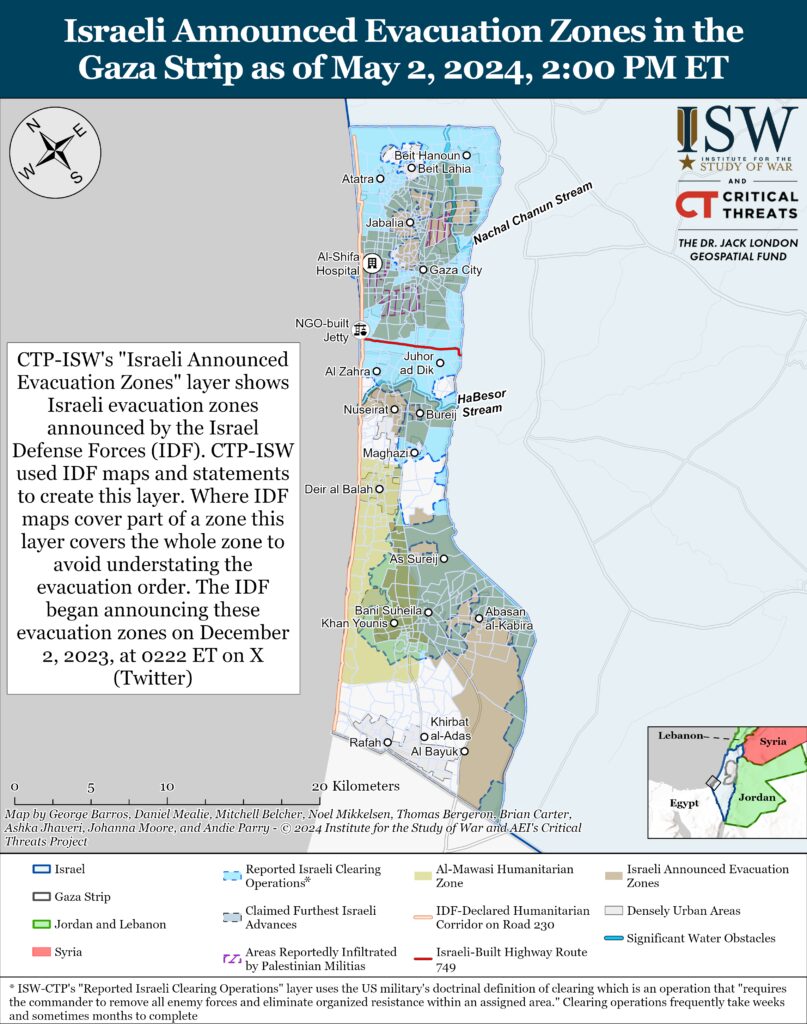A Lebanese media outlet published on May 1 the purported text of the Egyptian-proposed ceasefire agreement that Hamas is considering.[i] The reported proposal addresses all of Hamas’ maximalist demands except for a permanent ceasefire.[ii] Hamas would not likely adhere to a permanent ceasefire, however, given that Hamas has violated previous ceasefires and that Hamas remains committed to destroying Israel.[iii]
The purported Egyptian-proposed ceasefire agreement contains three phases and meets Hamas’ demands for a temporary ceasefire, the release of Palestinian prisoners, the delivery of more humanitarian aid to the Gaza Strip, and the reconstruction of the strip.[iv] The first 40-day phase would require Hamas to release at least 33 living Israeli hostages who are elderly, female, or injured in exchange for a temporary pause in fighting. The first phase also stipulates that the IDF withdraw eastward away from the populated areas of the Gaza Strip. The IDF would conduct a phased withdrawal from most of the Netzarim corridor to allow displaced Gazans to return to the northern Gaza Strip. Israel would furthermore allow the entry of 500 aid trucks into the Gaza Strip daily and cease aerial surveillance of the strip for parts of the day. Israel and Hamas would enter indirect negotiations to “restore sustainable calm” after the 16th day of the pause in fighting. Egyptian sources indicated to Western media that the “sustainable calm” could last up to a year.[v] The second phase of the proposed ceasefire reportedly stipulates that Hamas would release the remaining male Israeli civilians and soldiers in exchange for a full IDF withdrawal from the Gaza Strip and the release of an unspecified number of Palestinian prisoners. The third phase includes both sides exchanging dead bodies and the implementation of a five-year rehabilitation plan for the Gaza Strip. Hamas would be barred from rebuilding its military infrastructure during the five-year period, according to the Lebanese report.
Hamas has repeatedly refused to accept any ceasefire that does not meet its maximalist demands.[vi] Hamas has not changed these demands since December 2023.[vii] Hamas Political Bureau member Osama Hamdan said in an interview with Lebanese Hezbollah-affiliated media on May 2 that Hamas’ position on the ceasefire proposal is “negative” and that Hamas would stop negotiating if Israel launches a clearing operation into Rafah.[viii]
Accepting the ceasefire is inherently contradictory to Hamas’ objective of destroying Israel.[ix] Hamas initiated the current war by breaking a period of relative calm in its attack into Israel on October 7, 2023. A “permanent” truce would provide Hamas time to reconstitute itself militarily and reassert its political authority in the Gaza Strip, which CTP-ISW has previously assessed Hamas is trying to do.[x]
An Iranian-backed Bahraini militia claimed to have conducted a drone strike on the Israeli port city of Eilat on April 27.[xi] Saraya al Ashtar claimed the strike on May 2 and said that it targeted the headquarters of Israeli transportation company Trucknet Enterprise in Eilat.[xii] There is no definitive evidence at this time that the group conducted an attack, though Saraya al Ashtar published a video of its fighters launching a drone in an unspecified location.[xiii] Saraya al Ashtar suggested that it was part of a larger group called the Islamic Resistance in Bahrain and vowed that it would continue its attacks until Israel ends its military operations in the Gaza Strip.[xiv] This statement marks the first time that Saraya al Ashtar has signaled its participation in the Israel-Hamas war.
The claimed attack is part of the Iranian-led campaign to impose an unofficial blockade on Israel. Saraya al Ashtar emphasized the role of Trucknet Enterprise in facilitating Israeli overland trade.[xv] Trucknet Enterprise signed several agreements with Emirati companies in December 2023 to organize overland trade to the Persian Gulf and to mitigate the impact of Houthi attacks on international shipping.[xvi] Houthi attacks have reduced commercial operations at the port of Eilat and thus driven Israel to rely more on land routes through Jordan and the Gulf states to the Persian Gulf.[xvii] Saraya al Ashtar likely claimed the attack, regardless of whether it occurred, to deter companies and the Gulf states from supporting overland Israeli trade.
Iran and its so-called “Axis of Resistance” have repeatedly called for an unofficial blockade on Israel in recent months.[xviii] Houthi attacks on international shipping are part of this effort. Iran has also threatened the United Arab Emirates for cooperating with Israel, and Iranian-backed Iraqi militias have emphasized the need to severe the Israeli “land bridge” that passes through Jordan.[xix] Tehran and its allies appear to be operating on the theory that severe economic disruption would compel Israel to accept defeat in the Gaza Strip and that such economic pressure could ultimately collapse the Israeli state. Iranian leaders have repeatedly said in recent months that part of their theory on how to destroy Israel revolves around stoking instability and terror in Israel to catalyze reverse migration away from Israel.
Saraya al Ashtar claiming a drone attack marks the first time that the group has indicated that it has drone capabilities. Some observers noted that the drone that Saraya al Ashtar showed in its video resembles the Houthi Samad-2/3 drones, which have a range of around 1,500 kilometers.[xx] Saraya al Ashtar could threaten numerous US and partner positions throughout the Arabian Peninsula with that capability.
The Houthi supreme leader emphasized that the Houthis would continue their attacks against Israel and its interests until the destruction of the Israeli state. His remarks demonstrate that the Houthis will remain a serious threat to international shipping even in the event of a ceasefire in the Gaza Strip. Houthi supreme leader Abdulmalik al Houthi gave a speech on May 2 reaffirming his grand strategic objective of destroying Israel and describing the key role that he sees the Houthis having in achieving this goal.[xxi] Abdulmalik stated that a ceasefire in the Gaza Strip would only mean the “completion of this round of escalation” and that the long-term conflict against Israel would continue. Abdulmalik added that the Houthis will continue to support the Palestinian militias fighting Israel until “the end of [Israeli] control over Palestine and the cleansing” of Israeli people from Israeli territory.[xxii]
Iran is trying to use its military exports as a vehicle for expanding its influence in Africa. A French investigative outlet reported on April 30 that Iran and Niger have been negotiating a deal since late 2023 for Iran to provide military drones and surface-to-air missiles in exchange for 300 tons of uranium yellowcake.[xxiii] This quantity is especially significant given that Iran announced in 2019 its intent to produce that much yellowcake—300 tons—per year by 2024.[xxiv] A Nigerien delegation notably traveled to Tehran in January 2024 and signed unspecified agreements with Iranian officials, including Defense and Armed Forces Logistics Minister Brig. Gen. Mohammad Reza Gharaei Ashtiani.[xxv] Ashtiani is responsible for managing the Iranian defense industry as well as arms procurement and sales. Niger ended its counterterrorism partnership with the United States in March 2024 after US officials accused Niger of secretly exploring a deal to allow Iran access to Nigerien uranium reserves.[xxvi] Iranian Foreign Affairs Minister Hossein Amir Abdollahian met with the new Iranian ambassador to Niger, Ali Tiztak, the same day that Niger suspended its counterterrorism cooperation with the United States.[xxvii]
The Iranian negotiations with Niger come after Tehran similarly tried to use its defense exports to expand its influence in Sudan. Iran has supplied the Sudanese Armed Forces with drones, such as the Mohajer-6, to use against the Emirati-backed Rapid Support Forces.[xxviii] Western media reported in March 2024 that Iran requested Sudanese permission to establish a permanent naval base on the Red Sea in return for a helicopter-carrying warship.[xxix] CTP-ISW assessed at the time that Iran would use a naval base in Sudan to support out-of-area naval operations and attacks on international shipping in the Red Sea.[xxx]
The Iranian effort to expand its influence in Africa is especially noteworthy given that Iran recently hosted representatives from over 40 African countries during its second annual Iran-Africa Trade Summit from April 26-29.[xxxi] Iranian President Ebrahim Raisi, among other Iranian officials, met with the prime minister of Burkina Faso and vice president of Zimbabwe on the sidelines of the summit.[xxxii] The Zimbabwean vice president also discussed expanding military cooperation during a meeting with the Iranian defense minister, Ashtiani, on April 29.[xxxiii]
Key Takeaways:
- Gaza Strip: A Lebanese media outlet published the purported text of the Egyptian-proposed ceasefire deal that Hamas is considering. The agreement addresses almost all of Hamas’ demands except for a permanent ceasefire in the Gaza Strip. Hamas would likely violate a permanent ceasefire, however.
- Bahrain: An Iranian-backed Bahraini militia claimed to have conducted a drone strike on the Israeli port city of Eilat. The claimed attack is part of the Iranian-led campaign to impose an unofficial blockade on Israel. The Bahraini militia claiming a drone attack marks the first time that the group has indicated that it has drone capabilities.
- Yemen: The Houthi supreme leader emphasized that the Houthis would continue their attacks against Israel and its interests until the destruction of the Israeli state. His remarks demonstrate that the Houthis will remain a serious threat to international shipping even in the event of a ceasefire in the Gaza Strip.
- Africa: Iran is trying to use its military exports as a vehicle for expanding its influence in Africa. Iran and Niger are negotiating over a deal that would send Iranian weapons to Niger in exchange for Iranian access to Nigerien uranium reserves. Iran previously tried to use its military exports to Sudan to receive Sudanese permission to establish an Iranian naval base on the Red Sea.

Gaza Strip
Axis of Resistance objectives:
Erode the will of the Israeli political establishment and public to sustain clearing operations in the Gaza Strip
Reestablish Hamas as the governing authority in the Gaza StripThe Israel Defense Forces (IDF) Air Force struck Palestinian fighters and military infrastructure in the central Gaza Strip on May 2. The IDF 679th Brigade (99th Division) directed an airstrike targeting Palestinian fighters in an unspecified area in the central Gaza Strip.[xxxiv] The IDF Air Force, in coordination with the 99th Division, separately struck an “operational shaft” and a mortar launcher in an unspecified area in the central Gaza Strip.[xxxv]
The al Aqsa Martyrs’ Brigades —the self-proclaimed militant wing of Fatah—and Mujahideen Brigades targeted Israeli forces with mortar and rocket fire along the Netzarim corridor in separate attacks on May 2.[xxxvi] The Netzarim corridor is where Israeli forces have established forward positions to facilitate future raids into the northern Gaza Strip.[xxxvii] Palestinian militias have claimed near daily attacks targeting Israeli forces near the Netzarim corridor since April 18.[xxxviii]


Recorded reports of attacks; CTP-ISW cannot independently verify impact.
West Bank
Axis of Resistance objectives:
Establish the West Bank as a viable front against IsraelIsraeli forces engaged Palestinian fighters in at least one location in the West Bank on May 2.[xxxix] The al Aqsa Martyrs’ Brigades detonated IEDs and fired small arms targeting Israeli forces in Jalzone.[xl]
Israeli forces detained three PIJ fighters in January 2024 accused of planning bombing attacks in the West Bank, according to a Times of Israel report on May 2.[xli] Shin Bet reported that the fighters were preparing remote-detonated devices for “significant attacks” targeting Israeli forces. The IDF seized “several” explosive devices ready for use while arresting the fighters in Yabed. Shin Bet said that the PIJ headquarters in Lebanon directed the bombing attacks and provided funding to the fighters through cryptocurrency.

This map is not an exhaustive depiction of clashes and demonstrations in the West Bank.
Southern Lebanon and Golan Heights
Axis of Resistance objectives:
Deter Israel from conducting a ground operation into Lebanon
Prepare for an expanded and protracted conflict with Israel in the near term
Expel the United States from SyriaIranian-backed fighters, including Lebanese Hezbollah, have conducted at least three attacks from southern Lebanon into northern Israel since CTP-ISW’s last data cutoff on May 1.[xlii] Hezbollah shelled and fired unspecified munitions targeting Israeli forces in Shtoula and the Zibdin barracks.[xliii] The IDF reported that four munitions were fired from southern Lebanon targeting Israeli forces surrounding Mount Dov.[xliv] Unspecified fighters also fired two anti-tank guided munitions damaging two buildings in Shtoula.[xlv] Israeli forces destroyed Hezbollah infrastructure in Shebaa Farms and targeted Hezbollah fighters in Markaba.[xlvi]

Recorded reports of attacks; CTP-ISW cannot independently verify impact.
Iran and Axis of Resistance
The Islamic Resistance in Iraq—a coalition of Iranian-backed Iraqi militias—claimed two drone attacks targeting a “vital target” in the Golan Heights and Eilat, Israel, on May 1.[xlvii] Israeli officials and media have not commented on the attacks at the time of this writing. CTP-ISW cannot verify the attack claims.
Iranian Foreign Affairs Minister Hossein Amir Abdollahian discussed strengthening ties with Lebanon in a meeting with Iranian Ambassador to Lebanon Mojtaba Amani on May 2.[xlviii] Abdollahian stressed importance of Lebanon in the Iranian-led Axis of Resistance and in countering Israel.[xlix]
Iran is using its recent drone and missile attack on Israel to promote Iranian military exports. Brig. Gen. Mohammad Shirazi, who is the chief of the Iranian supreme leader’s military office, suggested on May 2 that Supreme Leader Ali Khamenei wants Iranian military officials to more actively promote Iranian military capabilities to domestic and foreign audiences. Shirazi highlighted the IRGC Aerospace Exhibition in Tehran as an example of how other services of the Iranian armed forces should promote their “achievements.”[l] A senior IRGC official separately showcased Iranian drones and missiles used in the April 13 attack on Israel while giving CNN a tour of the IRGC Aerospace Exhibition on May 2.[li] Iran has similarly capitalized on the Russian use of Iranian drones in Ukraine to advertise Iranian drones to potential buyers in Africa and Latin America.[lii]
An anti-Iranian regime outlet based in the United Kingdom circulated a letter claiming to contain hundreds of Iran-Iraq war veterans’ signatures condemning the recent death sentence of prominent Iranian rapper Toumaj Salehi.[liii] An Iranian revolutionary court sentenced Salehi to death on the charge that he supported the 2022-23 Mahsa Amini protest movement in Iran on April 24.[liv] The letter was purportedly a “warning” signed by 460 Iran-Iraq war veterans to regime leadership for prosecuting innocent civilians. The signatories separately condemned the regime for mismanagement and for committing violence against girls who participated in the Mahsa Amini movement.[lv] Iran-Iraq war veterans have historically comprised of some of the most ardent supporters of the regime, making the letter, if authentic, particularly noteworthy.[lvi] CTP cannot verify the authenticity of this letter, however.
 Eurasia Press & News
Eurasia Press & News




